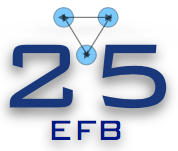Speaker
Description
In this talk, we present a summary of our recent research results on describing systems near the unitary limit using simple potentials, specifically Gaussian potentials[1-5].
In the parameter region where the energy of either the two-particle bound state or the virtual state is small, the physics can be effectively described by the scattering length and the effective range alone. Different systems with varying scales exhibit a universal correlation, independent of the specific type of interaction. This justifies the use of simple interactions such as Gaussian potentials.
We demonstrate how a Gaussian potential can be extended to capture the physics of systems with three or more particles. We present two approaches to utilizing the Gaussian characterization. The first approach focuses on describing two-particle sectors, such as two- and three-particle systems, enabling the prediction of energy properties of few-body systems at the unitary point. The second approach aims to describe the physical system up to the continuum, necessitating the inclusion of an additional three-body force to ensure system stability at the thermodynamic limit.
We also discuss potential avenues for improving the aforementioned framework and explore possible connections with traditional Effective Field Theory approaches.
References
[1] A. Kievsky, M. Gattobigio, L. Girlanda, and M. Viviani, Annu. Rev. Nucl. Part. Sci. 71, 465 (2021).
[2] A. Kievsky, A. Polls, B. Juli ́a-D ́ıaz, N. K. Timofeyuk, and M. Gattobigio, Phys. Rev. A 102, 063320 (2020).
[3] P. Recchia, A. Kievsky, L. Girlanda, and M. Gattobigio, Few-Body Syst 63, 8 (2022).
[4] P. Recchia, A. Kievsky, L. Girlanda, and M. Gattobigio, Phys. Rev. A 106 (2022).
[5] M. Gattobigio, A. Kievsky, and M. Viviani, Phys. Rev. C 100, 034004 (2019)

